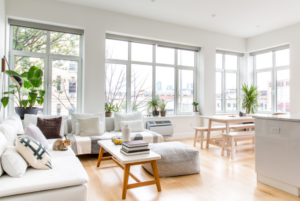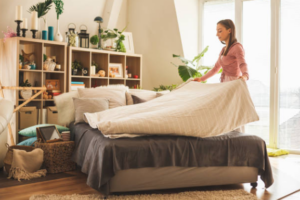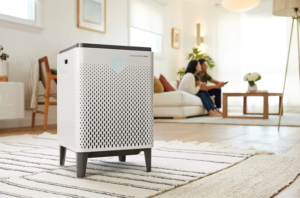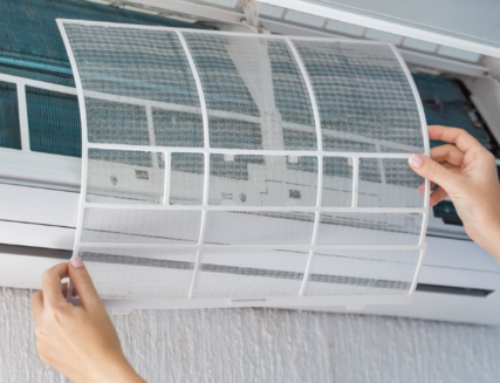How Do You Make Your Home More Hygienic And Healthier?
In the colder months of the year, make your Home more Hygienic and Healthier by feeling cozy and snug against the cold, but winter could be problematic if you have allergies or respiratory problems. Stale indoor air and inefficient heating systems can lead to an increase in dust mites, pet dander, and mold spores that trigger allergy symptoms.
When the weather is chilly in late winter and early spring, you may be unable to open your windows to let fresh air into the house. In anticipation of the warmer weather, keep in mind some allergies and respiratory triggers that may lurk around you.

We all want to ensure that our indoor living spaces are as sanitary and healthy as possible since most of us spend more time at home than we have for years. Because no fresh air flows outside during the winter, indoor air quality tends to worsen because allergens are trapped inside. The following tips will help you increase the overall cleanliness of your home along with your usual cleaning routine and vacuuming.
Enhancing Air Quality
By improving indoor air quality, you can avoid asthma flare-ups and allergy symptoms and breathe easier during the winter.
Making simple changes will help reduce your exposure to allergens within your home while likely not eliminating them all. You can follow these strategies to improve indoor air quality and minimize allergy symptoms.
- Keep your home clean. Keeping a house clean can reduce dust and animal dander from harming your health. Focus on cleaning strategies to ensure your home does not accumulate pet dander, mold, or dust.
- Use a HEPA-equipped vacuum cleaner once or twice weekly to vacuum carpets and area rugs. A home with hard-surface flooring will also reduce allergens since wall-to-wall carpeting can trap dust.
- Keep bedding, drapes, and other items clean, as they are prone to attracting allergens, especially if you have pets. We recommend washing pillows in water that is at least 130 degrees Fahrenheit as a precaution against allergy. In addition, dust mite-proof covers should be used whenever possible on pillows, mattresses, and box springs.
- Keep the greenery outdoors. Indoor plants can collect and foster mold growth. If indoor allergens are a problem, you’ll want to avoid them. Some plants release oxygen, but they can trigger allergies.
- Make sure your filters are clean. Be sure to change the filters in your forced-air heating system regularly. By using electrostatic filters, you can prevent dust and other airborne contaminants from recirculating throughout your house.
- Clean your ducts as well to get rid of trapped dust. Although this may only be advisable in some cases, it can be beneficial occasionally.
- You may benefit from an air purifier if you suffer from allergies to indoor allergens and cannot control the source. Devices like ionic purifiers can help keep irritants out of your house by placing them in popular areas. While you won’t be able to eliminate these allergens, you can reduce their presence, which may be helpful.
- Consider a dehumidifier. If you have a damp basement, you may also want to install a dehumidifier to help prevent mold growth. Bathrooms, another potential mold source, should be well-ventilated, and you should scrub visible mold off of walls, fixtures, and showers.
- Allow fresh air to enter. It is essential to allow fresh air to move into the house, even in the coldest months. Utilize fans in the kitchen to remove cooking fumes to rid the air of potential contaminants.
Keep Your Shoes Off When You’re At Home
There are a lot of germs hiding in your shoes. You’ll see them everywhere, including parking lots and public restrooms. Your home becomes a breeding ground for tons of allergens and microorganisms. Make it a policy to leave all shoes at the front door to increase safety and health.
Make Your Bedroom Clean & Dust Mite-Free

Sheets are usually washed once a week by most people. We recommend you launder your linens in the hottest water possible to kill dust mites. You should also clean your pillows, blankets, and duvets every few months in addition to your sheets. Consequently, you can eliminate germs, dirt, and allergies-causing dust mites.
Keep Your Tech Devices Clean
Throughout the day, you constantly touch your phone and other technology devices. The germs on these items can be harmful and can make you sick. Whenever you reach for these items, disinfecting wipes is an excellent way to ensure they are clean.
Keep An Eye On The Bathroom
There are more germs in your bathroom than in any other room in your house. Whenever you finish washing your bath or shower, dry the walls. The experts suggest flushing the toilet with the lid closed and disinfecting the bathroom floor once a week.
Invest In A Whole-Home Air Purification System
Air purification systems can significantly improve your home’s air quality when installed with your HVAC unit. You can reduce dander, seasonal allergens, dust, and more. Your HVAC system will last longer if you add a purifier because dirt and dust won’t get inside the components.
Gibber Services can help you find the best indoor air quality solution for your home based on the unique characteristics of your home. Call us today at 901-422-1258 if you would like more information.






